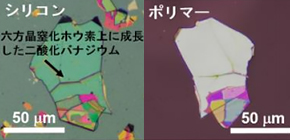
A world first: growth of functional oxides on layered substance that can be affixed to various materials
Will be applied to the development of smart windows
A group of researchers at the Institute of Scientific and Industrial Research succeeded in the growth of thin films of vanadium dioxide (VO 2 ) on hexagonal boron nitride (hBN). VO 2 is anticipated as a future electronics material, while hBN thin film can be affixed to virtually anywhere.
Ceramic material VO 2 exhibits insulator-to-metal phase transition in response to external stimuli, such as heat, light, and mechanical strain, and is expected to be applied to switches and sensors. To apply VO 2 to electronic devices, it is necessary to grow VO 2 on a substrate. For growth of VO 2 on substrates, ceramic materials such as sapphire were used; however, VO 2 on hard substrates such as ceramics was difficult to use in flexible devices and paper devices despite a recent rapid growth in its demand.
The researchers demonstrated that it was possible to grow a VO 2 thin film on hBN, a multilayered material that can be affixed to any material. Using viscous polymer materials, they removed the layered structure of hBN and VO 2 from the substrate and transferred it onto another material, such as glass or paper, without breaking the structure.
This group’s achievements will lead to the development of novel flexible devices that make use of properties of VO 2 . Findings in this study will be applied to functional oxides other than VO 2 . It is anticipated that the results of this study will lead to the development of novel VO 2 -based flexible devices, paper devices, wearable sensors capable of sensing changes in body temperature, and smart windows which can be affixed to windows of any shape.
Figure 1
Related links
